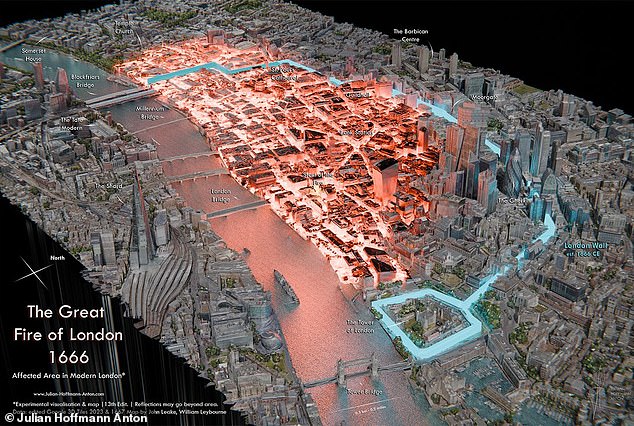In 1666 a devastating fire swept through London, destroying 13,200 houses and leaving an estimated 100,000 people homeless.
The inferno, which started at a bakery in Pudding Lane on Sunday 2 September, spread throughout the city thanks to a powerful wind and a very dry summer.
The blaze devastated the capital for four whole days but remarkably, only six deaths were recorded.
It’s hard to imagine what havoc a similar blaze would wreak on the city if it were to occur today.
Julian Hoffman Anton, a data visualization designer, has mapped the path of the Great Fire of London onto the modern-day city.
It shows that if the same fire were to spread in 2025, it would engulf almost all of the City of London including most of Holborn and Fleet Street.
The Walkie Talkie building would be demolished, and both Bank and Cannon Street Stations would be devastated.
The Ned hotel would be caught up in the blaze, along with Leadenhall Market and St Paul’s Cathedral.
The map shows which modern London landmarks would be affected if the same fire broke out today

A replica of 17th-century London on a barge floating on the river Thames burns in an event to mark the 350th anniversary of the Great Fire of London, in London on September 4, 2016

If the fire happened today, the Walkie Talkie building (pictured) would be demolished, and both Bank and Cannon Street Stations would be devastated
However, the map shows the fire would narrowly miss Moorgate, the Gherkin and the Tower of London.
Fortunately, the blaze, which took place more than 350 years ago, did not spread south of the river because a previous fire had already destroyed a section of London Bridge.
At the time, it’s thought the fire was kept alive and spread so far thanks to densely packed wooden houses, thatched roofs and warehouses that were full of flammable materials such as oil and tallow.
The city was also full of sheds and yards packed with hay and straw.
‘In 1666 there was no organised fire brigade,’ Jane Rugg, curator at the London Fire Brigade museum, said.
‘Firefighting was very basic with little skill or knowledge involved.
‘Leather buckets, axes and water squirts were used to fight the fire, but had little effect.’
Samuel Pepys, a man who lived at the time, kept a diary that has been well-preserved and helps to provide astonishing insight into the event.

If the same fire were to spread in 2025, it would engulf almost all of the City of London, including Bank station (pictured)

The Ned hotel would be caught up in the blaze, along with Leadenhall Market and St Paul’s Cathedral
People forced to evacuate their homes chose to bury or hide what valuables they couldn’t carry.
Mr Pepys himself buried his expensive cheese and wine before fleeing.
His diary from Monday 3 September reads: ‘About four o’clock in the morning, my Lady Batten sent me a cart to carry away all my money, and plate, and best things, to Sir W. Rider’s at Bednall-greene.
‘Which I did riding myself in my night-gowne in the cart; and, Lord! to see how the streets and the highways are crowded with people running and riding, and getting of carts at any rate to fetch away things.’
Mr Pepys, a Clerk to the Royal Navy, spoke to the admiral of the Navy who agreed they should blow up houses in the path of the fire to stop the spread.
The Navy – which had been using gunpowder at the time – carried out the request and the fire was mostly under control by Wednesday, 5 September 1666.
However small fires continued to break out and the ground remained too hot to walk on for several days afterwards.
Pepys recorded in his diary that even the King, Charles II, was seen helping to put out the fire.
‘I’m always exploring new ways to make data memorable by adding a creative twist,’ Mr Anton told MailOnline.
‘This map blends my passion for cinematic visuals, 3D, history, and London, bringing the past back to life into the present.
‘It’s difficult to imagine the true scale of historical events in a city that has changed so much; flat and ancient maps often struggle to convey this.
‘Creating this map has changed how I see the streets I walk every day and deepened my appreciation for the treasure trove that is London. I hope to share that feeling with others, by creating insightful data art.’
While fire always has the potential to be devastating, it’s unlikely the blaze would spread so far and burn for so long if it were to occur in today’s London.
Buildings are now made of much less-flammable materials such as concrete and brick, and fire brigades are much better equipped to deal with infernos.
Once the 1666 fire was put out London had to be almost totally reconstructed.
Temporary buildings were erected which were ill-equipped, and disease spread easily. Many people died from this and the harsh winter that followed.
The total cost of the fire was estimated to be £10 million, at a time when London’s annual income was around £12,000.
A 202-foot monument, built between 1671 and 1677, now marks the site where the fire first started.










